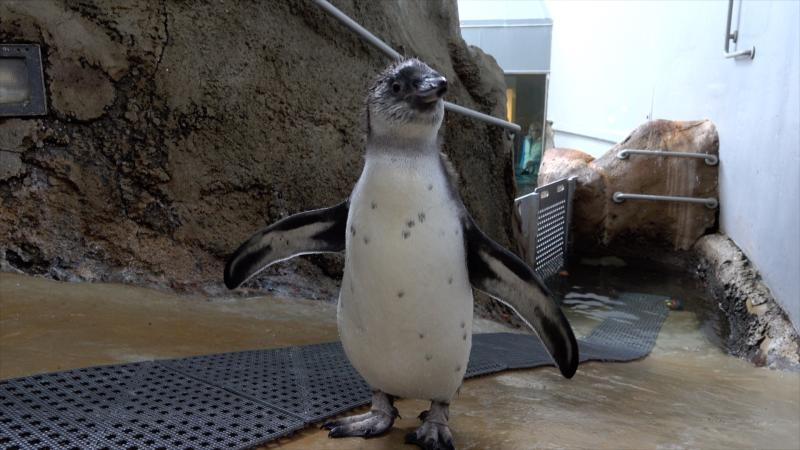Pool time goes swimmingly for Humboldt penguin chick

Oregon Zoo’s youngest penguin, Ópalo, ventures out of the nest and into the water
Ópalo, the Oregon Zoo’s new Humboldt penguin chick is leaving the nest and hitting the pool. The chick, who hatched in late March, has spent the past month and a half in her nest box, growing feathers and preparing to swim.
“She couldn’t wait to get in the water,” said Travis Koons, who oversees the zoo’s penguin area. “Before long she’ll be much faster in the water than she is on land.”
Once penguins grow their adult feathers, they can swim right away, Koons said — no lessons needed. Ópalo followed penguin care staff to the “kiddie pool” — a shallow area adjacent to the Penguinarium’s deeper waters — and waddled right in, kicking her webbed feet and tipping her head underwater to explore the bottom.
Ópalo is the first Humboldt chick to hatch at the Oregon Zoo since 2020, and the 194th since the zoo began breeding the threatened species in the 1980s. She’s nearly as tall as her parents now, but still easy to spot: Young Humboldts are gray and lack the tuxedo-like plumage of the full-grown penguins — notably the distinctive horseshoe-shaped band on their chest area.
Ópalo’s name — Spanish for “opal” — was inspired by Peruvian opal, the national stone of Peru.
Humboldt penguins, which live along the South American coastline off of Peru and Chile, are classified as “vulnerable” by the International Union for Conservation of Nature, and in 2010 were granted protection under the U.S. Endangered Species Act.
Of the world’s 17 penguin species, Humboldts are among the most at risk, threatened by overfishing of their prey species, entanglement in fishing nets, and breeding disruption due to commercial removal of the guano deposits where the penguins lay their eggs. Their population is estimated at 32,000 adult birds and declining.
More News

Rescued cougar cubs are venturing out
A pair of orphaned cougar cubs, rescued and brought to the zoo by Washington Department of Fish and Wildlife staff in November, have begun exploring their outdoor habitat.April 17, 2025

Zoo seeks pika watchers for summer season
The Oregon Zoo is recruiting volunteers for Cascades Pika Watch.April 15, 2025

Zoo convenes action for imperiled elephants
Sabah government representatives joined conservation NGOs, local communities, palm oil producers, and tourism operators this week in the fight to save the world’s smallest elephants from extinction.April 11, 2025

